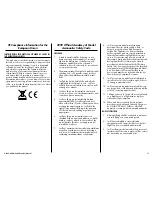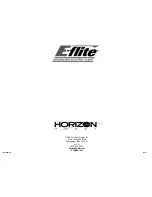
13
E-flite P-40 Warhawk Assembly Manual
Aileron high Rate
Up
5/16-inch (8mm)
Down
5/16-inch (8mm)
Aileron Low Rate
Up
1/2-inch
(6mm)
Down
1/2-inch
(6mm)
Elevator high Rate
Up
3/16-inch (5mm)
Down
3/16-inch (5mm)
Elevator Low Rate
Up
5/32-inch (4mm)
Down
5/32-inch (4mm)
Measurements are taken at the inner or
widest point on the control surface.
You will notice that the elevator throw for the P-40
has very little travel. This is due to the sensitivity
of the elevator. The elevator is very responsive
and will not require any more travel than this.
These are general guidelines measured from our own
flight tests. You can experiment with higher rates to
match your preferred style of flying.
Travel Adjust, Sub Trim and Exponential are
not listed and should be adjusted according
to each individual model and preference.
Center of gravity
An important part of preparing the aircraft for flight is
properly balancing the model.
Caution: do not inadvertently skip this step!
The recommended Center of Gravity (CG) location for
your model is 1
1
/
8
to 1
1
/
4
inches (28–35mm) back
from the leading edge of the wing at the inside edge
next to the fuselage. Make sure to measure from the
farthest point forward for accuracy. Mark the location
for the Center of Gravity on the top of the wing next to
the fuselage as shown. Make sure to check the balance
point with the flight battery installed.
Adjust the speed control and receiver as necessary so
the model hangs level or slightly nose down. This is the
correct balance point for your model.
After the first flights, the CG position can be adjusted
for your personal preference.
Preflight
Check your Radio
Before going to the field, be sure that your batteries
are fully charged per the instructions included with
your radio. Charge both the transmitter and receiver
pack (if so equipped) for your airplane. Use the
recommended charger supplied with your particular
radio system, following the instructions provided with
the radio. In most cases, the radio should be charged
the night before going out flying.
Before each flying session, be sure to range check your
radio. See your radio manual for the recommended
range and instructions for your radio system. Each
radio manufacturer specifies different procedures
for their radio systems. Next, start the motor. With
the model securely held by a helper (staying clear
of the propeller), check the range again. The range
test should not be significantly affected. If it is, don’t
attempt to fly! Have your radio equipment checked out
by the manufacturer.
Note
: Keep loose items that can get entangled
in the propeller away from the prop. These
include loose clothing, or other objects such as
pencils and screwdrivers. Especially keep your
hands away from the propeller.
Double-check that all controls (aileron, elevator and
throttle) move in the correct direction.
Check the radio installation and make sure all the
control surfaces are moving correctly (i.e. the correct
direction and with the recommended throws). Test run
the motor and make sure it transitions smoothly from
off to full throttle and back. Also ensure the motor is
installed according to the manufacturer’s instructions,
and it will operate consistently.
Check all the control horns, servo horns, and clevises
to make sure they are secure and in good condition.
Repair or replace any items that would be considered
questionable. Failure of any of these components in
flight would mean the loss of your aircraft.
Содержание P-40 Warhawk 300
Страница 19: ...19 E flite P 40 Warhawk Assembly Manual...






































